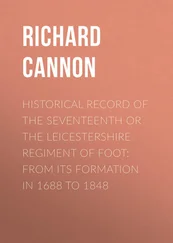Richard Cannon - Historical Record of the First Regiment of Foot
Здесь есть возможность читать онлайн «Richard Cannon - Historical Record of the First Regiment of Foot» — ознакомительный отрывок электронной книги совершенно бесплатно, а после прочтения отрывка купить полную версию. В некоторых случаях можно слушать аудио, скачать через торрент в формате fb2 и присутствует краткое содержание. Жанр: foreign_antique, foreign_prose, на английском языке. Описание произведения, (предисловие) а так же отзывы посетителей доступны на портале библиотеки ЛибКат.
- Название:Historical Record of the First Regiment of Foot
- Автор:
- Жанр:
- Год:неизвестен
- ISBN:нет данных
- Рейтинг книги:4 / 5. Голосов: 1
-
Избранное:Добавить в избранное
- Отзывы:
-
Ваша оценка:
- 80
- 1
- 2
- 3
- 4
- 5
Historical Record of the First Regiment of Foot: краткое содержание, описание и аннотация
Предлагаем к чтению аннотацию, описание, краткое содержание или предисловие (зависит от того, что написал сам автор книги «Historical Record of the First Regiment of Foot»). Если вы не нашли необходимую информацию о книге — напишите в комментариях, мы постараемся отыскать её.
Historical Record of the First Regiment of Foot — читать онлайн ознакомительный отрывок
Ниже представлен текст книги, разбитый по страницам. Система сохранения места последней прочитанной страницы, позволяет с удобством читать онлайн бесплатно книгу «Historical Record of the First Regiment of Foot», без необходимости каждый раз заново искать на чём Вы остановились. Поставьте закладку, и сможете в любой момент перейти на страницу, на которой закончили чтение.
Интервал:
Закладка:
1
A company of 200 men would appear thus: —

The musket carried a ball which weighed 1/10 of a pound; and the harquebus a ball which weighed 1/23 of a pound.
2
The 30th, 31st, and 32nd Regiments were formed as Marine corps in 1702, and were employed as such during the wars in the reign of Queen Anne. The Marine corps were embarked in the Fleet under Admiral Sir George Rooke, and were at the taking of Gibraltar, and in its subsequent defence in 1704; they were afterwards employed at the siege of Barcelona in 1705.
3
The brave Sir Roger Williams, in his Discourse on War, printed in 1590, observes: – "I persuade myself ten thousand of our nation would beat thirty thousand of theirs (the Spaniards) out of the field, let them be chosen where they list." Yet at this time the Spanish infantry was allowed to be the best disciplined in Europe. For instances of valour displayed by the British Infantry during the Seventy Years' War, see the Historical Record of the Third Foot, or Buffs.
4
Vide the Historical Record of the First, or Royal Regiment of Foot.
5
"Under the blessing of Divine Providence, His Majesty ascribes the successes which have attended the exertions of his troops in Egypt, to that determined bravery which is inherent in Britons; but His Majesty desires it may be most solemnly and forcibly impressed on the consideration of every part of the army, that it has been a strict observance of order, discipline, and military system, which has given the full energy to the native valour of the troops, and has enabled them proudly to assert the superiority of the national military character, in situations uncommonly arduous, and under circumstances of peculiar difficulty." General Orders in 1801.
In the General Orders issued by Lieut. – General Sir John Hope (afterwards Lord Hopetoun), congratulating the army upon the successful result of the Battle of Corunna, on the 16th of January, 1809, it is stated: – "On no occasion has the undaunted valour of British troops ever been more manifest. At the termination of a severe and harassing march, rendered necessary by the superiority which the enemy had acquired, and which had materially impaired the efficiency of the troops, many disadvantages were to be encountered. These have all been surmounted by the conduct of the troops themselves; and the enemy has been taught, that whatever advantages of position or of numbers he may possess, there is inherent in the British officers and soldiers a bravery that knows not how to yield, – that no circumstances can appal, – and that will ensure victory when it is to be obtained by the exertion of any human means.
6
Bishop Lesley; and Abercromby's Martial Achievements of the Scots Nation.
7
L'Escosse Françoise, par A. Houston; and the Translator's Preface to Beauge's History of the Campaigns in 1548 and 1549.
8
Bishop Lesley; and Philip de Commines.
9
List of the French army printed at the time.
10
L'Ecosse Françoise, par A. Houston.
11
Histoire de la Milice Françoise, par Le Père Daniel. 2 tom. 4to. Paris, 1721.
12
The companies obtained from the Netherlands were part of a distinguished body of Scots, who had been many years in the service of the States-General of the United Provinces; and were, in consequence of a truce having been concluded for 12 years, at liberty to engage in the service of Sweden. Vide Historical Record of the Third Foot .
13
Introduction de Puffendorf, tome iv. p. 84.
14
Harte's Life of Guslavus Adolphus.
15
The regiment alluded to was raised by Donald Mackay, Lord Reay, in 1626, for the service of the King of Denmark; it was afterwards in the service of the King of Sweden, and was reduced in 1634 to one company. In 1637, Colonel Robert Monro, who had served in the regiment from the time it was raised, published an historical account of its services, under the title of Monro's Expedition ; from which history much valuable information has been obtained relating to the Royal Regiment, and its first Colonel, Sir John Hepburn, who had lived in terms of intimacy and strict friendship with Colonel Monro from the time they were schoolfellows.
16
Monro's expedition; and Harte's Life of Gustavus Adolphus.
17
Swedish Intelligencer.
18
Monro's Expedition.
19
The Imperialists had previously enacted a cruel tragedy on a party of Scots at Old Brandenburg.
20
Harte's Life of Gustavus Adolphus; Monro's Expedition; and the Swedish Intelligencer.
21
In a list of Gustavus's army published at the time, in the Mercure François , the regiment is stated to have displayed four colours at the battle of Leipsic.
22
"The King having noticed that the Duke of Saxony was leaving the field, and that Count Tilly was ready to charge his main body, selected 2,000 musketeers of the brave Scots nation, and placed 2,000 horse on their flanks. The Scots formed themselves in several bodies of six or seven hundred each, with their ranks three deep (the King of Sweden's discipline being never to march above six deep;) the foremost rank falling on their knees, the second stooping forward, and the third standing upright, and all giving fire together, they poured, at one instant, so much lead amongst the enemy's horse, that their ranks were broken, and the Swedish horse charging, the enemy were routed." — Account of the battle of Leipsic published at the time.
23
"We were as in a dark cloud, not seeing the half of our actions, much less discerning either the way of our enemies, or the rest of our brigades; whereupon, having a drummer by me, I caused him to beat the Scots March , till it cleared up, which re-collected our friends unto us." — Monro's Expedition.
24
Monro's Expedition.
25
"His Majesty, accompanied by a great and honourable train of cavaliers, alighted from his horse at the head of our brigade; the officers coming together about his Majesty in a ring, his Majesty made a speech of commendation of the brigade, thanking them for their good service, and exhorting them to the continuation thereof, promised he would not forget to reward them; and turning towards the superior officers, they did kiss his Majesty's hand; the inferior officers and soldiers crying aloud, they hoped to do his Majesty better service than ever they had done." — Monro's Expedition.
26
Harte.
27
"The foot brigades were commanded to their several posts. Colonel Hepburn's brigade (according to custom) was directed to the most dangerous post, next the enemy; and the rest to theirs. The night coming on, we began our approaches, and prepared for making ready our attacks, when certain men were ordered to make cannon baskets, some to provide materials, some to watch, some to dig, some to guard the artillery, some to guard the workmen, and some to guard the colours before the brigade. The day approaching, we having made ready the batteries in the night, the service on both sides beginneth with cannon and musket." — Monro's Expedition.
Читать дальшеИнтервал:
Закладка:
Похожие книги на «Historical Record of the First Regiment of Foot»
Представляем Вашему вниманию похожие книги на «Historical Record of the First Regiment of Foot» списком для выбора. Мы отобрали схожую по названию и смыслу литературу в надежде предоставить читателям больше вариантов отыскать новые, интересные, ещё непрочитанные произведения.
Обсуждение, отзывы о книге «Historical Record of the First Regiment of Foot» и просто собственные мнения читателей. Оставьте ваши комментарии, напишите, что Вы думаете о произведении, его смысле или главных героях. Укажите что конкретно понравилось, а что нет, и почему Вы так считаете.












